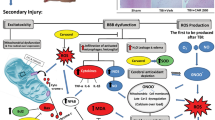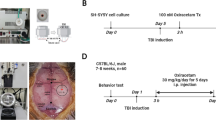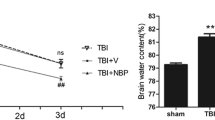Abstract
The aim of this study was to evaluate the therapeutic efficacy of caffeic acid phenethyl ester (CAPE) with an experimental traumatic brain injury (TBI) model in rats. Twenty-four adult male Sprague–Dawley rats were randomly divided into three groups of 8 rats each: control, TBI, and TBI + CAPE treatment. In TBI and TBI + CAPE treatment groups, a cranial impact was delivered to the skull from a height of 7 cm at a point just in front of the coronal suture and over the right hemisphere. Rats were sacrificed at 4 h after the onset of injury. Brain tissues were removed for biochemical and histopathological investigation. To date, no biochemical and histopathological changes of neurodegeneration in the frontal cortex after TBI in rats by CAPE treatment have been reported. The TBI significantly increased tissue malondialdehyde (MDA) levels, and significantly decreased tissue superoxide dismutase (SOD) and glutathione peroxidase (GPx) activities, but not tissue catalase (CAT) activity, when compared with controls. The administration of a single dose of CAPE (10 μmol/kg) 15 min after the trauma has shown protective effect via decreasing significantly the elevated MDA levels and also significantly increasing the reduced antioxidant enzyme (SOD and GPx) activities, except CAT activity. In the TBI group, severe degenerative changes, shrunken cytoplasma and extensively dark picnotic nuclei in neurons, as well as vacuolization indicating tissue edema formation. The morphology of neurons in the CAPE treatment group was well protected. The number of neurons in the trauma alone group was significantly less than that of both the control and TBI +CAPE treatment groups. The caspase 3 immunopositivity was increased in degenerating neurons of the traumatic brain tissue. Treatment of CAPE markedly reduced the immunoreactivity of degenerating neurons. TBI caused severe degenerative changes, shrunken cytoplasma, severely dilated cisternae of endoplasmic reticulum, markedly swollen mitochondria with degenerated cristae and nuclear membrane breakdown with chromatin disorganization in neurons of the frontal cortex. In conclusion, the CAPE treatment might be beneficial in preventing trauma-induced oxidative brain tissue damage, thus showing potential for clinical implications. We believe that further preclinical research into the utility of CAPE may indicate its usefulness as a potential treatment on neurodegeneration after TBI in rats.



Similar content being viewed by others
References
Aebi H (1974) Catalase in vitro. Methods Enzymol 105:121–126
Baethmann A, Maier-Hauff K, Schürer L, Lange M, Guggenbichler C, Vogt W, Jacob K, Kempski O (1989) Release of glutamate and free fatty acids in vasogenic brain edema. J Neurosurg 70:578–591
Bramlett HM, Dietrich WD (2004) Pathophysiology of cerebral ischemia and brain trauma: similarities and differences. J Cereb Blood Flow Metab 24:133–150
Cernak I, Chapman SM, Hamlin GP, Vink R (2002) Temporal characterisation of pro- and anti-apoptotic mechanisms following diffuse traumatic brain injury in rats. J Clin Neurosci 9:565–572
Clark RS, Kochanek PM, Chen M, Watkins SC, Marion DW, Chen J, Hamilton RL, Loeffert JE, Graham SH (1999) Increases in Bcl-2 and cleavage of caspase-1 and caspase-3 in human brain after head injury. FASEB J 13:813–821
Clark RS, Kochanek PM, Watkins SC, Chen M, Dixon CE, Seidberg NA, Melick J, Loeffert JE, Nathaniel PD, Jin KL, Graham SH (2000) Caspase-3 mediated neuronal death after traumatic brain injury in rats. J Neurochem 74:740–753
Cristofori L, Tavazzi B, Gambin R, Vagnozzi R, Vivenza C, Amorini AM, Di Pierro D, Fazzina G, Lazzarino G (2001) Early onset of lipid peroxidation after human traumatic brain injury: a fatal limitation for the free radical scavenger pharmacological therapy. J Investig Med 49:450–458
Erhardt L (1996) Biochemical markers in acute myocardial infarction—the beginning of a new era? Eur Heart J 17:1781–1782
Fadillioglu E, Oztas E, Erdogan H, Yagmurca M, Sogut S, Ucar M, Irmak MK (2004) Protective effects of caffeic acid phenethyl ester on doxorubicin-induced cardiotoxicity in rats. J Appl Toxicol 24:47–52
Fadillioglu E, Gursul C, Iraz M (2010) Effects of caffeic acid phenethyl ester on thioacetamide-induced hepatic encephalopathy in rats. Prog Neuropsychopharmacol Biol Psychiatr 34(8):1440–1445
Gaetz M (2004) The neurophysiology of brain injury. Clin Neurophysiol 115:4–18
Hepsen IF, Bayramlar H, Gultek A, Ozen S, Tilgen F, Evereklioglu C (1997) Caffeic acid phenethyl ester to inhibit posterior capsule opacification in rabbits. J Cataract Refract Surg 23:1572–1576
Hicdonmez T, Kanter M, Tiryaki M, Parsak T, Cobanoglu S (2006) Neuroprotective effects of N-acetylcysteine on experimental closed head trauma in rats. Neurochem Res 31:473–481
Hsu SM, Raine L, Fanger H (1981) Use of avidin-biotin-peroxidase complex (ABC) in immunperoxidase techniques: a comparison between ABC and unlabeled antibody (PAP) procedures. J Histochem Cytochem 29:577–580
Ikeda Y, Long DM (1990) The molecular basis of brain injury and brain edema: the role of oxygen free radicals. Neurosurgery 27:1–11
Ilhan A, Koltuksuz U, Ozen S, Uz E, Ciralik H, Akyol O (1999) The effects of caffeic acid phenethyl ester (CAPE) on spinal cord ischemia/reperfusion injury. Eur J Cardiothorac Surg 16:458–463
Irmak MK, Koltuksuz U, Kutlu NO, Yağmurca M, Ozyurt H, Karaman A, Akyol O (2001) The effect of caffeic acid phenethyl ester on ischaemia-reperfusion injury in comparison with alpha-tocopherol in rat kidneys. Urol Res 29:190–193
Keane RW, Kraydieh S, Lotocki G, Alonso OF, Aldana P, Dietrich WD (2001) Apoptotic and antiapoptotic mechanisms after traumatic brain injury. J Cereb Blood Flow Metab 21:1189–1198
Khan M, Khan M, Elango C, Ansari MA, Singh I, Singh AK (2007) Caffeic acid phenethyl ester reduces neurovascular inflammation and protects rat brain following transient focal cerebral ischemia. J Neurochem 102(2):365–377
Koltuksuz U, Ozen S, Uz E, Aydinç M, Karaman A, Gültek A, Akyol O, Gürsoy MH, Aydin E (1999) Caffeic acid phenethyl ester prevents intestinal reperfusion injury in rats. J Pediatr Surg 34:1458–1462
Kus I, Colakoglu N, Pekmez H, Seckin D, Ogeturk M, Sarsilmaz M (2004) Protective effects of caffeic acid phenethyl ester (CAPE) on carbon tetrachloride-induced hepatotoxicity in rats. Acta Histochem 106:289–297
Langlois JA, Rutland-Brown W, Wald MM (2006) The epidemiology and impact of traumatic brain injury: a brief overview. J Head Trauma Rehabil 21:375–378
Lewén A, Skoglösa Y, Clausen F, Marklund N, Chan PH, Lindholm D, Hillered L (2001) Paradoxical increase in neuronal DNA fragmentation after neuroprotective free radical scavenger treatment in experimental traumatic brain injury. J Cereb Blood Flow Metab 21:344–350
Lowry OH, Rosebrough NJ, Farr AL, Randall RI (1951) Protein measurement with the folin phenol reagent. J Biol Chem 193:265–275
Lu J, Moochhala S, Shirhan M, Ng KC, Teo AL, Tan MH, Moore XL, Wong MC, Ling EA (2003) Neuroprotection by aminoguanidine after lateral fluid-percussive brain injury in rats: a combined magnetic resonance imaging, histopathologic and functional study. Neuropharmacology 44:253–263
Marshall LF (2000a) Epidemiology and cost of central nervous system injury. Clin Neurosurg 46:105–112
Marshall LF (2000b) Head injury: recent past, present, and future. Neurosurgery 47:546–561
Marshall LF, Maas AI, Marshall SB, Bricolo A, Fearnside M, Iannotti F, Klauber MR, Lagarrigue J, Lobato R, Persson L, Pickard JD, Piek J, Servadei F, Wellis GN, Morris GF, Means ED, Musch B (1998) A multicenter trial on the efficacy of using tirilazad mesylate in cases of head injury. J Neurosurg 89:519–525
McCall JM, Braughler JM, Hall ED (1987) Lipid peroxidation and the role of oxygen radicals in CNS injury. Acta Anaesthesiol Belg 38:279–373
McCord JM, Fridovich I (1969) Superoxide dismutase. An enzymic function for erythrocuprein (hemocuprein). J Biol Chem 244(22):6049–6055
Mcintosh TK, Juhler M, Wieloch T (1998a) Novel pharmacologic strategies in the treatment of experimental traumatic brain injury. J Neurotrauma 15:731–769
McIntosh TK, Saatman KE, Raghupathi R, Graham DI, Smith DH, Lee VM, Trojanowski JQ (1998b) The Dorothy Russell Memorial Lecture. The molecular and cellular sequelae of experimental traumatic brain injury: pathogenetic mechanisms. Neuropathol Appl Neurobiol 24:251–267
Montpied P, De Bock F, Rondouin G, Niel G, Briant L, Courseau AS, Lerner-Natoli M, Bockaert J (2003) Caffeic acid phenethyl ester (CAPE) prevents inflammatory stress in organotypic hippocampal slice cultures. Mol Brain Res 115:111–120
Nagaoka T, Banskota AH, Tezuka Y, Saiki I, Kadota S (2002) Selective antiproliferative activity of caffeic acid phenethyl ester analogues on highly liver-metastatic murine colon 26–L5 carcinoma cell line. Bioorg Med Chem 10:3351–3359
Nicholson DW (1999) Caspase structure, proteolytic substrates, and function during apoptotic cell death. Cell Death Differ 6:1028–1042
Nortje J, Menon DK (2004) Traumatic brain injury: physiology, mechanisms, and outcome. Curr Opin Neurol 17:711–718
Ogeturk M, Kus I, Colakoglu N, Zararsiz I, Ilhan N, Sarsilmaz M (2005) Caffeic acid phenethyl ester protects kidneys against carbon tetrachloride toxicity in rats. J Ethnopharmacol 97:273–280
Ohkawa H, Ohishi N, Yagi K (1979) Assay for lipid peroxides in animal tissues by thiobarbituric acid rection. Anal Biochem 95:351–358
Ozen S, Akyol O, Iraz M, Sogut S, Ozugurlu F, Ozyurt H, Odacı E, Yildirim Z (2004) Role of caffeic acid phenethyl ester, an active component of propolis, against cisplatin-induced nephrotoxicity in rats. J Appl Toxicol 24:27–35
Ozisik PA, Oruckaptan H, Ozdemir Geyik P, Misirlioglu M, Sargon MF, Kivanc K, Ozgen T (2007) Effect of erythropoietin on brain tissue after experimental head trauma in rats. Surg Neurol 68:547–555
Ozsüer H, Görgülü A, Kiriş T, Cobanoğlu S (2005) The effects of memantine on lipid peroxidation following closed-head trauma in rats. Neurosurg Rev 28:143–147
Ozyurt H, Irmak MK, Akyol O, Sogut S (2001) Caffeic acid phenethyl ester changes the indices of oxidative stress in serum of rats with renal ischemia-reperfusion injury. Cell Biochem Funct 19:259–263
Paglia DE, Valentine WN (1967) Studies on the quantitative and qualitative characterisation of erythrocyte glutathione peroxidase. J Lab Clin Med 70:158–169
Porter AG, Janicke RU (1999) Emerging roles of caspase-3 in apoptosis. Cell Death Differ 6:99–104
Rink A, Fung KM, Trojanowski JQ, Lee VM, Neugebauer E, McIntosh TK (1995) Evidence of apoptotic cell death after experimental traumatic brain injury in the rat. Am J Pathol 47:1575–1583
Russo A, Longo R, Vanella A (2002) Antioxidant activity of propolis: role of caffeic acid phenethyl ester and galangin. Fitoterapia 73:21–29
Scatton B, Carter C, Benavidas J, Giroux C (1991) N-methyl-D-aspartate receptor antagonists: a novel therapeutic perspective for the treatment of ischemic brain injury. Cerebrovasc Dis 1:121–135
Shapira Y, Shohami E, Sidi S, Soffer D, Freeman S, Cotev S (1988) Experimental closed head injury in rats: mechanical, pathophysiologic and neurologic properties. Crit Care Med 16:258–265
Siesjo BK (1993) Basic mechanisms of traumatic brain damage. Ann Emerg Med 22:959–969
Stoica BA, Faden AI (2010) Cell death mechanisms and modulation in traumatic brain injury. Neurotherapeutics 7:3–12
Sun Y, Oberley LW, Li Y (1988) A simple method for clinical assay of superoxide dismutase. Clin Chem 34:497–500
Teasdale GM, Graham DI (1998) Craniocerebral trauma: protection and retrieval of the neuronal population after injury. Neurosurgery 43:723–738
Thomale UW, Griebenow M, Kroppenstedt SN, Unterberg AW, Stover JF (2006) The effect of N-acetylcysteine on posttraumatic changes after controlled cortical impact in rats. Intensive Care Med 32:149–155
Ustun ME, Gürbilek M, Ak A, Vatansev H, Duman A (2001) Effect of magnesium sulfate on tissue lactate and malondialdehyde levels in experimental head trauma. Intensive Care Med 27:264–268
Vagnozzi R, Marmarou A, Tavazzi B, Signoretti S, Di Pierro D, del Bolgia F, Amorini AM, Fazzina G, Sherkat S, Lazzarino G (1999) Changes of cerebral energy metabolism and lipid peroxidation in rats leading to mitochondrial dysfunction after diffuse brain injury. J Neurotrauma 16:903–913
Yakovlev AG, Knoblach SM, Fan L, Fox GB, Goodnight R, Faden AI (1997) Activation of CPP32-like caspases contributes to neuronal apoptosis and neurological dysfunction after traumatic brain injury. J Neurosci 17:7415–7424
Author information
Authors and Affiliations
Corresponding author
Rights and permissions
About this article
Cite this article
Kerman, M., Kanter, M., Coşkun, K.K. et al. Neuroprotective effects of Caffeic acid phenethyl ester on experimental traumatic brain injury in rats. J Mol Hist 43, 49–57 (2012). https://doi.org/10.1007/s10735-011-9376-9
Received:
Accepted:
Published:
Issue Date:
DOI: https://doi.org/10.1007/s10735-011-9376-9




